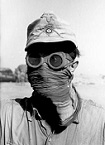Peltonx
Posts: 7250
Joined: 4/9/2006
Status: offline

|
quote:
ORIGINAL: el hefe
Sorry, Pelton, I don't agree with your assessment that Army Group North didn't have any logistical issues. It is true that Army Group North was definitely better off due to the better quality rail system in the Baltics but they were also in constant crisis mode just like the other AGs. There were constant fuel shortages and supply deliveries did not meet Army Group North's daily requirements. Fuel and ammunition shortages were consistent with all Army Groups as was the rapidly declining capacity of the truck columns that were expected to deliver the supplies from the forward depots. Supply issues did severely impede Army Group North from making the progress that they had planned for.
Trey
quote:
I disagree and so does history
The German Concentration of Forces Against the Soviet Border
From the moment Hitler alerted the armed forces in late July 1940 for an attack on Soviet Russia, the army general staff thought in terms of rail schedules to execute the Aufmarsch (concentration) for Barbarossa and regauging or rebuilding the Soviet rail system for logistical support of the advance. Generalleutnant Rudolf Gercke, chief of German army transportation, began to oversee the railroad tasks under the first important OKW order for Barbarossa, the Ausbau Ost (Eastern Buildup) order of 9 August 1940, directing the improvement and expansion of eastern Poland's rail system. The Reichsbahn (State Rail Service) and the Ostbahn (Eastern Rail Service) began to build up the eastern rail facilities under the codeword, Program Otto. Concomitantly, Gercke was largely responsible for coordinating the transfer of thirty-five German infantry divisions from France to Poland and East Prussia, using existing facilities, at a leisurely pace from July to October 1940. By 17 January 1941, Gercke informed OKW that of the 8,500 km of rail lines to be improved or rebuilt to concentrate forces for Barbarossa, 60 percent had been completed, most double track.{4} On 2 February 1941, Brauchitsch and Halder began the concentration of forces for Barbarossa, intended to be in four waves of rail movement lasting through 15 May 1941.
Due to unexpected circumstances, including the Balkan campaign and the severe winter of 1940-1941, the German concentration of forces continued until 22 June. Amazingly, the OKH moved some 17,000 trains over and above the normal traffic in the east after the battle of France.{5} Through secrecy and deception, the German command achieved almost complete tactical and operational surprise against the Soviet armed forces and a large measure of strategic surprise against the high political leadership. Stalin and his advisors received warnings of German aggressive intent months before, but they reasonably discounted most of such warnings based on alternate explanations and the vast deceptive circumstance that Germany was at war with Britain. The Soviets must also have had aggressive intentions of their own. Retrospectively, it appears possible that they were preparing to attack Germany or dient states of Germany possibly as early as autumn 1941, and probably no later than summer 1942. Finally, although Stalin was prepared for German political pressure in the summer of 1941, and possibly even military incidents, he was caught totally off guard by a full-blooded military invasion with the Olympian mission to defeat the Soviet state immediately. The unobtrusive movement of 17,000 extra trains to the east and the deceptive explanation of unconcealable activity associated with the concentration of forces made possible the surprise on 22 June 1941, which could have translated into the defeat of Soviet Russia.
Gercke executed the eastern movement in waves beginning with the more innocuous infantry divisions and only a few mobile divisions at a maximum of twelve trains daily along each of the six main rail lines established under Program Otto. The chief of army transportation moved seven infantry and two mobile divisions in the first wave (relatively few), among which it was possible to disguise one panzer and one motorized infantry division. The Germans were extremely sensitive about transferring mobile divisions to the east. They were operating according to the doctrine that panzer divisions and closely associated motorized infantry divisions were to be employed exclusively for deep strategic offensive missions. The Germans assumed with a mirror-image mentality that the Soviets would immediately recognize danger regarding the excessive number of panzer divisions in the east. Accordingly, they left the overwhelming mass of the mobile divisions until the last possible moment for movement eastward. Table II illustrates the German sensitivity to ensuring surprise and the magnitude of the Aufmarsch for Barbarossa:
Table 11. Barbarossa Concentration of Forces (Aufmarsch)*
German Wave and Time Divisions Trains
Wave 1, 2 February—14 March 1941 9 ñ. 14,000 trains divisions
Wave 2, March 1941 18
Wave 3, 8 April—20 May 1941 17 ñ. 3,000 trains for Luftwaffe, army troops, supply and reserve forces
Wave 4a, 23 May—2 June 1941 9
Wave 4b, 3 June—23 June 1941 24
Beginning 21 June—24 July 1941 24
Totals 101 17,000 trains
* Prior to the concentration, the Germans had 47 divisions in the east that eventually took part in the invasion: 12 divisions from the Polish campaign and 35 divisions emplaced between July and October after the French campaign.
In Wave 4b, the last wave of the divisions that launched the attack across the frontier on 22 June 1941 (a day later in a few cases because of the relatively narrow attack fronts), the Germans moved twenty-four panzer and motorized infantry divisions. These, with their tracked and wheeled motor vehides, were difficult to move and even more of a challenge to conceal. The Germans took major precautions to screen the movement of these divisions, then make them disappear into the countryside after offloading. Once this movement began, they considered it would have significant chances of being detected, and it could not be explained by any subterfuge. The Germans also delivered to the border by train an additional twenty-four divisions, which would not take part in the initial attacks but would move into former Soviet territory toward the front from 26 June 1941 onward.
German Rail Lines, Rail Heads, and Truck Columns In the Soviet Union
The trains that moved the German army and the Luftwaffe ground organization to the border could not deliver the armed forces farther east. The Germans would have to move tactically from the frontier and depend for support on the distance between their rail heads and the infantry divisions in the front lines. For the mobile divisions, it was the distance between the German railway system and the finger-like projections deep into Soviet territory. In Barbarossa, the Germans advanced rapidly into territory having no normal-gauge railroads. Logistics would depend on the German capabilities to advance their own rail system into the Soviet Union while simultaneously connecting German rail heads with their troops, disappearing over the horizon into Soviet Russia. An untold, unusual situation almost immediately after Barbarossa began supports a view that, logistically, the Germans had the capability to defeat the Soviet Union. In Army Group Center, seventeen German panzer and motorized infantry divisions did everything in their power to distance themselves from the German railheads. By 26 June 1941, the 7th Panzer Division was 300 km into the Soviet Union from its start on the Lithuanian border, and on the following day the 3d Panzer Division reached Glusa. 350 km into Russia. Current literature has not asked how the Germans could resupply two panzer divisions at that distance from rail heads in German territory. Obviously, they successfully organized truck columns with enormous capacities to run the supplies from the German border to the advancing armies.
By 26 April 1941, the quartermaster general of the German army and the chief of transportation had collected 25,020 tons (freight capacity) of trucks for Army Group Center and smaller amounts for the remaining two army groups.{6} When the campaign opened, the high command of the army provided Army Group Center with approximately 45,000 tons of trucks to deliver supplies from the rail heads on the border to the advancing armies. After a complex transition, their new rail heads were at various distances from the border in Soviet territory.{7} The Germans considered that the 60-ton (freight capacity) truck columns could bridge approximately 400 km between rail heads and the advancing field armies.{8} As the normal-gauge rail lines were constructed along the most important logistics routes into White Russia from Brest to Minsk, the Germans expected on 17 July to take off most of the 60-ton truck columns from the frontier to Minsk between 20 and 30 July 1941. The columns continued to run from the border in decreasing numbers until finally stopped on 5 August 1941.{9} By then, the rail lines were completed beyond Minsk, and the Germans would be operating from rail heads approaching Smolensk.
German Logistics: Quantity of Material and
Mode of Operations Required to Reach the Moscow-Gorki Space
To advance on Moscow in August 1941. the Germans depended logistically on the capacity and location of the rail system they had built by that time. The army high command massed strong forces of railway pioneer troops, battalions of the Reich Labor Service (Reich Arbeits Dienst, or RAD). and Organization Todt (ÎÒ) immediately behind the field armies to ensure construction of the normal-gauge rail lines, train stations, and marshalling yards. In Army Group North, the high command inserted 18,219 men for railway construction during June-August 1941,{10} The construction troops were organized along military lines, armed with rifles, pistols, and light machine guns, and advanced so aggressively behind the German combat formations that they reported 84 combat incidents with scattered Soviet troops. These resulted in 162 combat casualties to themselves. The Germans placed similar construction troops and special railway reconnaissance detachments with the panzer group spearheads to estimate damage and help pull the construction process forward. The details of German-gauge railway construction into the Soviet Union and the exploitation of undamaged Russian-gauge lines, locomotives, and rail cars support" a conclusion that the Germans accurately forecast the logistical necessities for Barbarossa and effectively executed the operations.
Gercke, chief of German army transportation, estimated that one railway battalion could change tracks from Russian to German gauge at a rate of 20 km per day.{11} Railway pioneer units also quickly employed Russian-gauge lines to help bring supplies forward even before they completed the German lines. They used both simultaneously, as long as Russian locomotives and rolling stock held out. On 24 June 1941, Railway Operations Company 203 took over the intact Soviet wide-gauge rail line from Brest to Zabinka, 30 km from the border. The company observed that the Russian-gauge line was intact for an additional 25 km eastward to the station at Tevii. The company began to reduce the haul of the 60-ton truck columns, already running far to the east to support Guderian's panzers, now 220 km on the road to the upper Dnieper at Rogachev.
The German railway pioneer and other construction troops simultaneously built normal-gauge rail lines at a fierce pace. advancing by 25 June some 80 km toward Minsk.{12} By 29 June, they extended normal-gauge track from the frontier at Brest to Oranczyce and, by I July. onto Baranovice.{13} As Gercke commented, a German railway pioneer battahon could replace wide-gauge line with normal at 20 km per day. The distance from Brest to Bara-novice is 210 km, a httle longer using the rail line. The Germans took eleven days to construct the new line, uncannily close to Gercke's estimate despite violent fighting on the southeastern lines of encirclement around the Bialystok pocket. Contrary to conventional interpretation of underestimating the challenges of a campaign in the Soviet Union, the Germans mastered logistics and built their own rail system into the Soviet Union.
Blitz Logistics: Normal Gauge Rail, Brest to Minsk
To operate the rail lines, the Germans had to regauge rail sidings and marshalling areas and, depending on battle damage, to repair buildings and equipment at the train stations.{14} On the most important rail line in Barbarossa, the tracks from Brest directly toward Moscow, the Germans completed the line from Brest to Oranczyce by 29 June 1941 and began to move German trains on normal-gauge track on 30 June. That day. four supply trains arrived at Oranczyce, 85 km into the Soviet Union, with approximately 2,000 tons of supplies. Meantime, regauging of Russian lines continued with work being completed to Baranovice junction by 2000, I July, and three trains reaching that city, 210 km into the Soviet Union. The Germans continued their impressive pace of building a normal-gauge rail system into White Russia and completed regaug-ing from Brest to the capital, Minsk, at noon on 5 July. Army Group Center ran four supply trains there the same day, more than 330 km into the Soviet Union.{15} By 5 July, the Germans began to develop a great rail head at Minsk, which capably supported the lightning panzer advance to Smolensk that overran the city on 16 July. In a historic performance, the Germans regauged the Russian rail system from Brest to Minsk by early July and extended construction to Smolensk before the end of the same month. Their performance established a logistical system able to support an offensive toward Moscow before the middle of August 1941 and bridge the gap between Smolensk and Moscow in a single offensive, similar in style to the earlier leaps to Minsk and Smolensk.
That generalization derives from the actions of Army Group Center from the middle of July to early August 1941. On 15 July 1941, the quartermaster general reviewed the supply status of, Army Group Center in terms of its capabilities to continue offensive operations. He made it clear that the great rail head for continuing operations lay in the cities of Minsk and Molodecno, no longer on the prewar frontier. The army group then had 45,450 tons of 60-ton truck columns and, deducting one-third as inoperable at any time and in repair, still had approximately 30,700 tons available for continuous operations.{16} In mid-July 1941 the German army transportation chief guaranteed the substantial total of fourteen trains and 6,300 tons of supplies daily for the Minsk-Molodecno base. The quartermaster general averred that, based on the logistical situation of 15 July 1941, Army Group Center could conduct an offensive on Moscow with four panzer, three motorized infantry, and ten infantry divisions with appropriate army reserves, maintaining the remainder of the army group in static fighting around Smolensk. This logistical feat was moderately impressive for the middle of July, with enough trains arriving at the Minsk-Molodecno railroad and more than enough trucks to move a panzer group and an infantry army to Moscow. Meanwhile, the Germans were fighting the battle of Smolensk and would take two more weeks to finish the job and another week to tidy up operationally. The Germans used this time to build up logistic stockpiles at the rail head in the center of White Russia and regauge the main rail line from Minsk through Orsha into Smolensk{17}.
By the second week of August 1941, Army Group Center regained operational freedom of movement. If the army group had been directed by Hitler and OKH at the end of July 1941 to continue operations toward Moscow as soon as possible, it would have eliminated remnants of Soviet forces in the great pocket just north of Smolensk and cleared the communications zone of Panzer Group Guderian to the south. Unhampered by Hitler's stubborn attempt to diffuse the combat strength of Army Group Center about the Russian countryside, and the battle between the Fuhrer and OKH over one decisive objective rather than many indecisive ones. Army Group Center would have entered a period of rest, rehabilitation, and stockpiling on approximately 5 August 1941. Regarding the logistical possibilities for an advance a little over a week later, on 13 August 1941, Army Group Center would receive almost double the number of trains daily it had received a month earher{18} — approximately twenty-four trains rather than fourteen. With time to establish larger stockpiles, and with rail heads advanced to Orsha and Smolensk, Army Group Center obviously had the logistical system to support its advance on Moscow with its entire strength{19}.
_____________________________
Beta Tester WitW & WitE
|
 Printable Version
Printable Version












 New Messages
New Messages No New Messages
No New Messages Hot Topic w/ New Messages
Hot Topic w/ New Messages Hot Topic w/o New Messages
Hot Topic w/o New Messages Locked w/ New Messages
Locked w/ New Messages Locked w/o New Messages
Locked w/o New Messages Post New Thread
Post New Thread